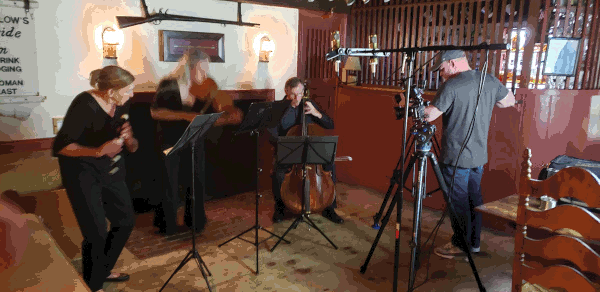
By Sarah Darling
It’s a question whose answers are many and nuanced, especially in a location like the Boston area. The past surrounds us in so many ways, large and small, that not being affected by it is not an option. What is very much an option is what we choose to do with its presence. Do we center it or treat it as a support? Do we attempt to re-create it,or do we attempt to enter into dialogue with it? Do we learn about it intellectually, or try to experience it with our own bodies?
As far as I’m concerned, the answer is - yes. Almost any way in will work, and the more simultaneous paths you take, the more likely it is that the past will take on the same nuance and complexity that the present holds, which it richly deserves. Early musicians are time travelers (time tourists, perhaps), and the more we can do to make the music we play exist in an era that feels like it could have been real,the better.
This intention was firing on all cylinders when Musicians of the Old Post Road decided to delve into a project that brought together historical sites in Sudbury with the “tunes of the time.” Taking a page from the pandemic video productions that we all know so well at this point, the group resolved to do something it could never do in a typical concert; move from space to space, playing music suited to each venue as we went. The end result is an offering which is part concert, part documentary, and which aspires to bring audience members as close in to this living history as possible.
As a musician engaged in this work, it was a wild ride to film and perform! Each venue hosts a conversation with a member of the Sudbury Historical Society as well as a musical offering. Creating a sense of unity and flow, so that the audience members feel that they are present in these spaces, requires an entire other level of extra consideration, before one even reaches the “heart” of the experience. Walking through the spaces, followed by the camera, is key for this. We logged a lot of hours strolling through rooms, opening doors, thinking about positions. I recall the feeling of floorboards creaking under my feet, heavy doors swinging, shifts of light as we went inside and outside, the smell of dust.
The initial inspiration for this project came from a walk taken by the group’s Artistic Directors, Dan Ryan and Suzanne Stumpf. They were at the Assabet River Wildlife Refuge when they came across a stone foundation half buried in the ground, likely an old cellar, and a marker that introduced the location as the Rice Tavern, active from 1700-1815. There’s nothing that marks the passage of time so clearly - so indelibly - as a ruin. You construct the rooms in your mind, the people and histories, the politics and commerce that must have run through this location during its extraordinarily long tenure.
One of the treats of this project was to have the chance to superimpose that silent vine-twined woodside foundation with a
bustling inn that has managed to survive intact from 1716 all the way to the present day - Longfellow’s Wayside Inn. Here, no mental building up is necessary, but instead a subtraction of sorts; a moving of the modern aspects of the building back into the technology and aesthetic of the past. The brilliant fact of Longfellow’s poem, the classic “Tales of a Wayside Inn” is helpful for placing it in a particular point in time, although it also creates a certain manufactured nostalgia that adds yet another layer to our relationship with the past.
Nearly every site that we interacted with required its own kind of mental activity before we could really inhabit it. Some - like Sudbury’s First Parish, where we regularly play concerts - are “regular” locations that offer up secrets in plain sight as you get to know them better and better. Others - like the Loring Parsonage and the Hosmer House - are fascinating, beautifully maintained true historical sites, intended to welcome the visitor directly into another world. Still others, the outdoor ones such as the Revolutionary War Cemetery and the Town Pound - read like artifacts. You can walk your body through them at any point, they are always open to the elements and constantly interacting with the present moment, but only as reminders of what has been.
Fortunately, as musicians, we have another way of interacting with these spaces. By playing our instruments inside each of them, we can both be present in them and, as much as possible, be in dialogue. Through some significant scholarly effort, the Old Post Road directors were able to uncover works by composers like Samuel Holyoke, Oliver Shaw, and Isaac Lane - Massachusetts musicians who were either writing or arranging at the various times that each of the historical sites were flourishing. We ended up doing everything from local arrangements of the Water Music (dubbed “Handel’s Water Piece”) to a period dance work called “Washington’s Minuet and Gavotte” to various fiddle tunes to a patriotic hymn entitled “Adams and Liberty” that forecast the tune of the Star Spangled Banner. The ways that these works are disseminated and transported are extremely interesting; at once similar and completely different to the modes of transmission we are now accustomed to.
It was a fascinating project, a really unique blend of many different aspects of music, history, architecture, and storytelling. But the most telling result for me personally is a lingering feeling that I now get as soon as I drive over the Sudbury Town Line. I am in this time, yes, but no longer only here.
